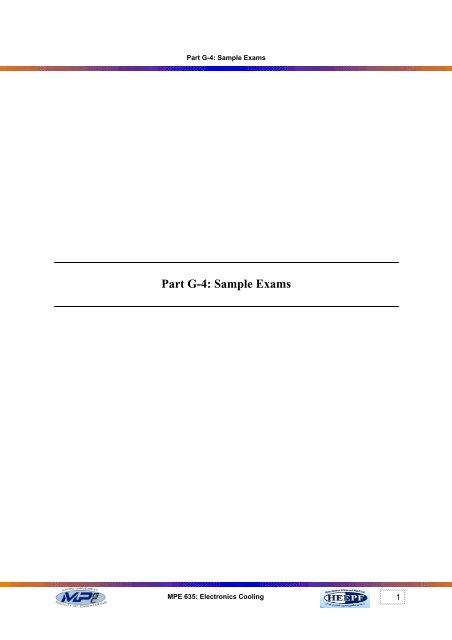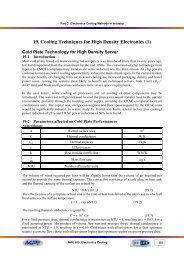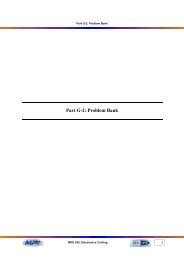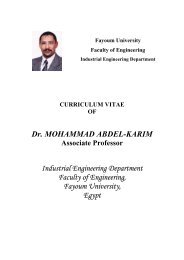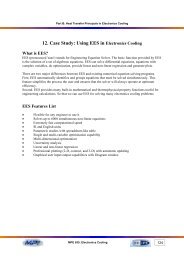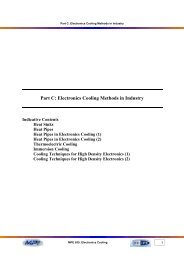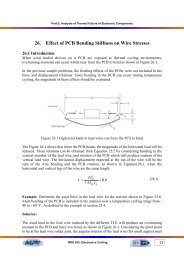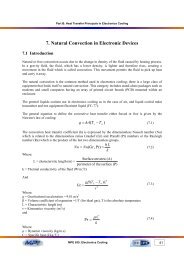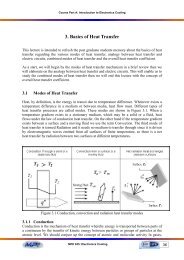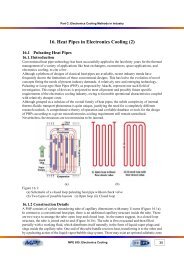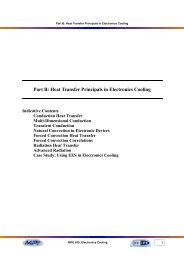Part G-4: Sample Exams
Part G-4: Sample Exams
Part G-4: Sample Exams
You also want an ePaper? Increase the reach of your titles
YUMPU automatically turns print PDFs into web optimized ePapers that Google loves.
<strong>Part</strong> G-4: <strong>Sample</strong> <strong>Exams</strong><br />
<strong>Part</strong> G-4: <strong>Sample</strong> <strong>Exams</strong><br />
MPE 635: Electronics Cooling<br />
1
<strong>Part</strong> G-4: <strong>Sample</strong> <strong>Exams</strong><br />
Cairo University<br />
M.Sc.: Electronics Cooling<br />
Faculty of Engineering Final Exam (<strong>Sample</strong> 1)<br />
Mechanical Power Engineering Dept.<br />
Time allowed 2 Hours<br />
Solve as much as you can.<br />
1. A heat sink constructed from 2024 aluminum alloy is used to cool a power diode dissipating<br />
5 W. The internal thermal resistance between the diode junction and the case is 0.8 °C/W,<br />
while the thermal contact resistance between the case and the heat sink is 10 -5 m 2 . °C/W.<br />
Convection at the fin surface may be approximated as that corresponding to a flat plate in<br />
parallel flow.<br />
a) Assuming that all the diode power is transferred to the ambient air through the rectangular<br />
fins; estimate the operating temperature of the diode.<br />
b) Explore options for reducing the diode temperature, subject to the constraints that the air<br />
velocity and fin length may not exceed 25 m/s and 20 mm, respectively, while the fin<br />
thickness may not be less than 0.5 mm. All other conditions, including the spacing between<br />
fins, remain as prescribed.<br />
2. Consider an array of vertical rectangular fins, which is lo be used lo cool an electronic device<br />
mounted in quiescent, atmospheric air at T ∞ = 27 °C. Each fin has L = 20 mm and H = 150 mm and<br />
operates at an approximately uniform temperature of T s = 77 °C. For the optimum value of fin<br />
spacing S and a fin thickness of t = 1.5 mm, estimate the rate of heat transfer from the fins for an<br />
array of width W = 355 mm.<br />
MPE 635: Electronics Cooling<br />
2
<strong>Part</strong> G-4: <strong>Sample</strong> <strong>Exams</strong><br />
3a. What are the factors affected on filter selection to be mounted on electronic chassis?<br />
3b. What's the difference between active and passive immersion cooling techniques?<br />
4. The interface temperature of an electronic assembly dissipating 10 W must be limited to 40<br />
o C in a 50 o C environment. It is assumed that all of the generated heat will be removed by<br />
thermoelectrics and that heat absorbed from the environment is negligible. The interface<br />
temperature difference between the assembly and the thermoelectric can be held to 2 o C. The<br />
temperature difference between the thermoelectric and ambient can be held to 8 o C. The<br />
bismuth telluride element used has a length of 0.3 cm and a cross-area of 0.01 cm 2 .<br />
Determine the size and performance characteristics of the thermoelectric temperature control<br />
device. Knowing that<br />
The equivalent material properties of the thermoelectric couples is<br />
ρ e = 0.00267 Ω.cm<br />
α e = 425 x 10 -6 V/K<br />
k e = 0.00785 W/cm.K<br />
NB: Design for maximum refrigeration capacity.<br />
5. Determine the axial force in the lead wire for the resistor shown in figure below, when<br />
bending of the PCB is included in the analysis over a temperature cycling range from -50 to<br />
+90 °C, which produce total horizontal displacement expected at the top of the wire will be<br />
0.0003 in. (Note: All dimensions in inches)<br />
Assuming that:<br />
E W = 16 x 10 6 Ib/in 2 (copper wire modulus elasticity)<br />
E P = 1.95 x 10 6 Ib/in 2 (PCB modulus of elasticity)<br />
MPE 635: Electronics Cooling<br />
3
<strong>Part</strong> G-4: <strong>Sample</strong> <strong>Exams</strong><br />
Cairo University<br />
M.Sc.: Electronics Cooling<br />
Faculty of Engineering Final Exam (<strong>Sample</strong> 2)<br />
Mechanical Power Engineering Dept.<br />
Time allowed 2 Hours.<br />
Solve as much as you can.<br />
1. Consider a surface-mount type transistor on a circuit board whose temperature is maintained<br />
at 35 °C. Air at 20 °C flows over the upper surface of dimensions 4 mm by 8 mm with a<br />
convection coefficient of 50 W/m 2 .K.Three wire leads, each of cross section 1 mm by 0.25 mm<br />
and length 4 mm, conduct heat from the case to the circuit board. The gap between the case and<br />
the board is 0.2 mm.<br />
a) Assuming the case is isothermal and neglecting radiation; estimate the case temperature<br />
when 150mW are dissipated by the transistor and (i) stagnant air or (ii) a conductive paste fills<br />
the gap. The thermal conductivities of the wire leads, air. And conductive pastes are 25, 0.0263,<br />
and 0.12 W/m.K. respectively.<br />
b) Using the conductive paste to fill the gap, we wish to determine the extent to which<br />
increased heat dissipation may be accommodated, subject to the constraint that the case<br />
temperature not exceeds 40 °C. Options include increasing the air speed to achieve a larger<br />
convection coefficient h and/or changing the lead wire material to one of larger thermal<br />
conductivity. Independently considering leads fabricated from materials with thermal<br />
conductivities of 200 and 400 W/m.K., compute and plot the maximum allowable heat<br />
dissipation for variations in h over the range 50 ≤ h ≤ 250 W/m 2 .K.<br />
2. A 35 W power transistor is fitted to a duralumin plate 150 x 165 mm and 5 mm thick. The<br />
plate is finned on the other side by 15 fins spaced 9 mm apart. The fins are 2 mm thick and<br />
protrude 40 mm. In an ambience of 40 °C, how long would it take this transistor, after turning<br />
it on, to be within 5 o C from its final temperature? Neglect effect of radiation.<br />
3a. Describe with neat sketch the components of a heat pipe.<br />
3b. Discuss briefly the types of Printed Wiring Board.<br />
MPE 635: Electronics Cooling<br />
4
<strong>Part</strong> G-4: <strong>Sample</strong> <strong>Exams</strong><br />
4. A circular transistor of 10 mm diameter is cooled by impingement of an air jet exiting a 2-<br />
mm diameter round nozzle with a velocity of 20 m/s and a temperature of 15 °C. The jet exit<br />
and the exposed surface of the transistor are separated by a distance of 10 mm. If the transistor<br />
is well insulated at all but its exposed surface and the surface temperature is not to exceed 85<br />
o C, what is the transistor's maximum allowable operating power?<br />
5. Determine the deflections and thermal stresses expected in the lead wires and solder joints<br />
of the surface mounted transformer shown in the following figure, when it is mounted on an<br />
aluminum composite PCB which experiences in plane (X and Y) thermal expansion during<br />
rapid temperature cycling tests over a temperature range from -30 to +80 °C, with no electrical<br />
operation. (Note: All dimensions in inches)<br />
Assuming that:<br />
a T = 35 x 10 -6 in/in/°C (average TCE of transformer)<br />
a P = 20 x 10 -6 in/in/°C (average TCE of composite PCB)<br />
E W = 16x10 6 psi (modulus of elasticity, copper wire)<br />
MPE 635: Electronics Cooling<br />
5
<strong>Part</strong> G-4: <strong>Sample</strong> <strong>Exams</strong><br />
Cairo University<br />
M.Sc.: Electronics Cooling<br />
Faculty of Engineering Final Exam (<strong>Sample</strong> 3)<br />
Mechanical Power Engineering Dept.<br />
Time allowed 2 Hours.<br />
Solve as much as you can.<br />
1. A square isothermal chip is of width w = 5 mm on a side and is mounted in a substrate such that<br />
its side and back surfaces are well insulated, while the front surface is exposed to the flow of a<br />
coolant at T ∞ = 15 °C. From reliability considerations, the chip temperature must not exceed T =<br />
85 °C.<br />
If the coolant is air and the corresponding convection coefficient is h = 200 W/m 2 .K. What is the<br />
maximum allowable chip power? If the coolant is a dielectric liquid for which h = 3000 W/m 2 .K.<br />
What is the maximum allowable power?<br />
2. A common procedure for cooling a high-performance computer chip involves joining the<br />
chip to a heat sink within which circular microchannels are machined. During operation, the<br />
''<br />
chip produces a uniform heal flux q<br />
c<br />
at its interface with the heat sink, while a liquid coolant<br />
(water) is routed through the channels. Consider a square chip and heat sink, each L x L on a<br />
side, with microchannels of diameter D and pitch S = C 1 D, where the constant C 1 is greater<br />
•<br />
than unity. Water is supplied at an inlet temperature T m,i and a total mass flow rate m (for the<br />
entire heat sink).<br />
''<br />
''<br />
a) Assuming that q<br />
c<br />
is dispersed in the heat sink such that a uniform heat flux q<br />
c<br />
is<br />
maintained at the surface of each channel; obtain expressions for the longitudinal distributions<br />
of the mean fluid, T m (x), and surface. T s (x), temperatures in each channel. Assume laminar,<br />
• ''<br />
fully developed flow throughout each channel, and express your results in terms of m . q<br />
c<br />
.<br />
C 1 , D, and/or L, as well as appropriate thermophysical properties.<br />
''<br />
b) For L = 12 mm, D = 1 mm, C 1 = 2, q<br />
c<br />
= 20 W/cm 2 •<br />
, m = 0.010 kg/s, and T m,i = 290 K, compute<br />
and plot the temperature distributions T m (x) and T s (x).<br />
''<br />
c) A common objective in designing such heat sinks is to maximize q<br />
c<br />
while maintaining the<br />
heat sink at an acceptable temperature. Subject to prescribed values of L = 12 mm and T m,i =<br />
290 K and the constraint that T s,max ≤ 50°C, explore the effect on q ''<br />
c<br />
of variations in heat sink<br />
design and operating conditions.<br />
MPE 635: Electronics Cooling<br />
6
<strong>Part</strong> G-4: <strong>Sample</strong> <strong>Exams</strong><br />
3a. Describe the limitation of operation with heat pipe.<br />
3b. What are the considerations that must be taken in electronics chassis design?<br />
4. A thermoelectric cooling system is to be designed to cool a PCB through cooling a<br />
conductive plate mounted on the back surface of the PCB. The thermoelectric cooler is aimed<br />
to maintain the external surface of the plate at 40 o C, when the environment is 48 o C. Each<br />
thermoelectric element will be cylindrical with a length of 0.125 cm and a diameter of 0.1 cm.<br />
The thermoelectric properties are:<br />
p<br />
n<br />
α (V/K) 170 x 10 -6 -190 x 10 -6<br />
ρ (Ω.cm) 0.001 0.0008<br />
k (W/cm K) 0.02 0.02<br />
Assume the cold junction at 38 o C and the warm junction at 52 o C, and the electrical resistance<br />
of the leads and junctions = 10 % of the element resistance and design for maximum<br />
refrigeration capacity. If 10 W are being dissipated through the plate and steady-state conditions<br />
then determine:<br />
1- Number of couples required.<br />
2- Rate of heat rejection to the ambient.<br />
3- The COP.<br />
4- The voltage drop across the d.c. power source.<br />
MPE 635: Electronics Cooling<br />
7
<strong>Part</strong> G-4: <strong>Sample</strong> <strong>Exams</strong><br />
5. Determine the resonant frequency of a rectangular plug-in epoxy fiberglass PCB simply<br />
supported (or hinged) on all four sides, 0.080 in thick, with a total weight of 1.0 pounds, as<br />
shown in figure. (Note: All dimensions in inches)<br />
Assuming that:<br />
E = 2 x 10 6 Ib/in 2 (PCB modulus of elasticity)<br />
µ = 0.12 (Poisson's ratio, dimensionless)<br />
MPE 635: Electronics Cooling<br />
8


